Trees
Featured Trees
|
American Beech American Holly American Sycamore Common or Hazel Alder Flowering Dogwood |
Loblolly
Pine Mockernut Hickory Red Maple Sweetgum |
Tulip Poplar Water Oak White Oak |
Information from the Georgia Forestry Commission
Autumn Leaves | Georgia Forest Facts | Native Trees of Georgia | Tree Benefits | What we get from trees?
Tree Species Fact Sheets
Images are from the Dendrology Fact Sheets at Virginia Tech
|
American Beech
(Fagus grandiflora) Shade-tolerant tree that grows to about 100 feet. American Beech produces edible nuts that are eaten by squirrels, raccoons, bears, and game birds. Leaves: Dark green simple leaves with small teeth along the margins. Bark: Thin, smooth, silver-gray bark. Bark remains smooth as tree ages. Fruit: Small nut borne in pairs within a 4-lobed husk. Habitat: Moist rich uplands and well-drained lowlands. Shaded areas of mature forests. |
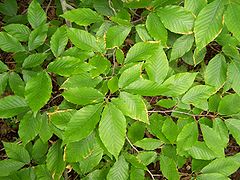 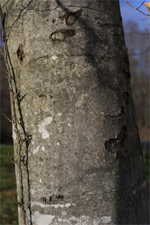 |
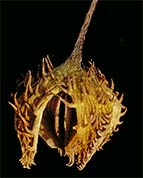 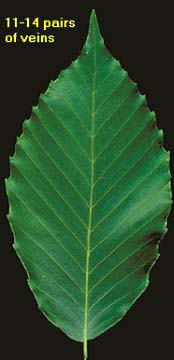 |
|
American Holly
(Ilex opaca) Evergreen tree growing to 60 feet tall. Branches with berries are popular Christmas decorations. Many kinds of birds and mammals eat the bitter-tasting berries. Leaves: Stiff alternate leaves with sharp, thorn-like points along the margins. Leaves remain on the branches for 2-3 years before falling off in the spring when pushed by growing buds. Bark: Light gray bark with warty bumps. Flowers and Fruit: Small white flowers. Fruits are bright red berries called drupes containing 4 seeds. Habitat: Slow-growing shade-tolerant tree of the understory |
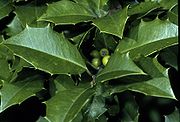 |
 |
|
American Sycamore (Platanus occidentalis) One of the largest eastern hardwoods with enlarged base, straight trunk and broad crown. Sycamore wood is used for furniture, flooring, and as particleboard. Sycamores can grow to over 100' tall and develop trunks that can reach about 10' in diameter. Leaves: Alternate, 4-8" (10-20 cm) with 3-5 sharp-pointed lobes and wavy serrated edges. Bark: Smooth, whitish, and mottled. Peels off in thin flakes. Flowers and Fruit: Tiny green flowers. Fruits are 1" diameter brown-colored balls hanging from stalk. Habitat: Wet soils along streams, floodplains, and edges of lakes and swamps. |
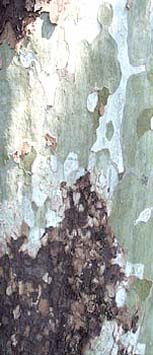 |
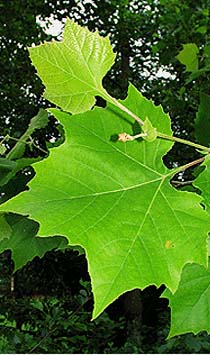 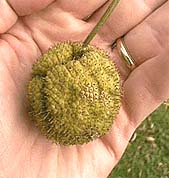 |
|
Common or Hazel Alder
(Alnus serrulata) Hazel alder grows into a large shrub or small tree in moist to wet places. Alder often grows into dense thickets. Hazel Alder is one of the first trees to flower in the spring. Hazel alder grow in or near the edge of the beaver pond area of Tumbling Creek. Leaves: Finely serrated leaf margins. Flowers: Flowers are yellowish and tiny and grow on catkins. Male catkins are droopy, whereas female catkins look like small cones and open up to release seeds. The female catkins stay attached until the following spring. Fruit: Dark brown nutlets that mature in autumn. Habitat: Moist to wet places along streams, ponds, lakes, and swamps. Preferred habitat is wet soils. |
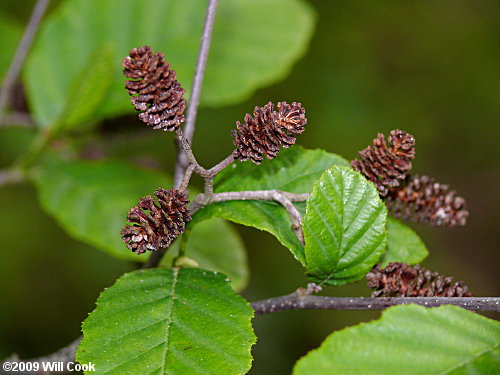 Female catkins. 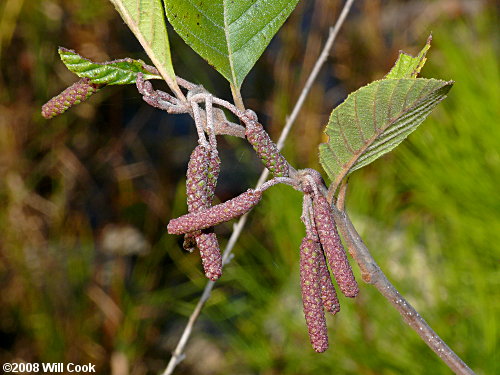 Male catkins |
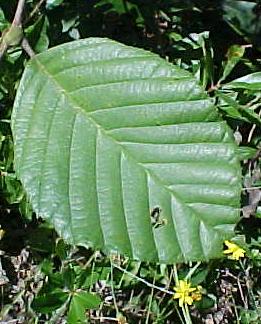 |
|
Flowering Dogwood
(Cornus florida) Small tree that rarely exceeds 30' with showy early spring flowers, red fruit, and bright red leaves in autumn. Flowering dogwood is often cultivated as an ornamental. Flowering dogwood is a beautiful springtime tree with showy flowers. The hard wood of the dogwood is used to make spools, small wooden pulleys, and mallet heads. Indians extracted a red dye from the roots.
Flowers: "Flowers" are actually infloresecences
made of compact clusters of small yellow florets. The four large
white "petals" that surround the florets are modified leaves
called bracts. The showy bracts give the appearance of petals.
|
  |
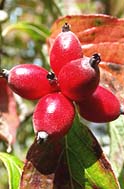 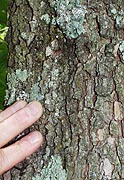 |
|
Loblolly Pine
(Pinus taeda) Rapidly growing, sun-loving yellow pine that is common in the southeast. Over 50% of the standing pine in the southeast is loblolly. Grown in commercial plantations for lumber and pulpwood for paper.Loblolly mayures in 150 years and can live for over 300 years. Leaves: Needles in bundles of 3 (4-9" long). Most needles remain on tree for 2 years before falling off giving the tree an evergreen look. Bark: Grayish-brown and furrowed into broad plates. Cones: The fruits of loblolly pine are dark brown cones, about 3-6 inches long. Cones are often paired. Habitat: Widespread, drought-tolerant and grows in a variety of soils. |
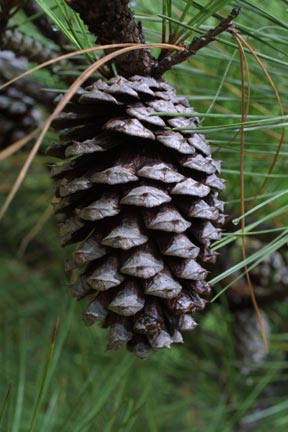 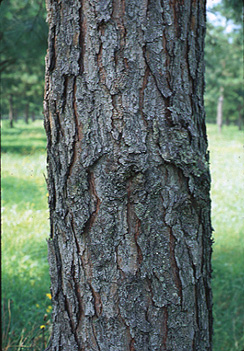 |
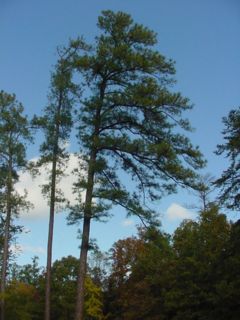 |
|
Mockernut Hickory
(Carya alba) Most abundant of the hickories and may live to the age of 500 years. Medium-sized and grow slowly up to 80 feet tall. Hickory wood is prized as firewood in that it will burn slowly for a long time. Smoke from the burning of hickory wood is used to smoke hams. Hickory nuts are eaten by squirrels and other wildlife. The leaves of hickory are aromatic when crushed. Leaves: Pinnately compound (7-9 leaflets) that grow up to 20 inches long. Bark: Gray with deep furrows. Fruit: Round or pear-shaped nuts about 1.5 inches long. Habitat: Associated with oak-hickory climax forest. Grow best in relatively fertile upland soils. |
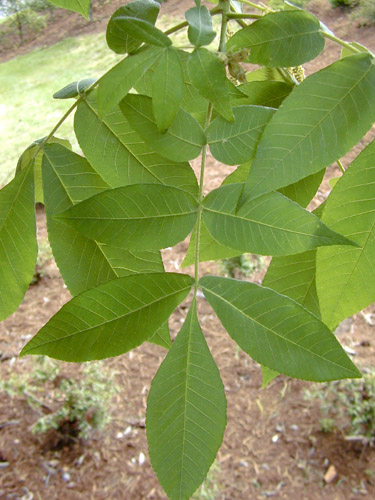 |
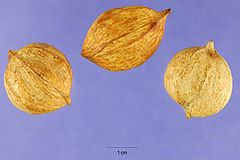 |
|
Red Maple
(Acer rubrum) One of the most common and widespread trees of eastern North America. Leaves turn red, orange and yellow in autumn. Pioneers extracted a reddish-brown dye from the bark. Leaves: Opposite leaves about 4" long with 3-5 palmate lobes and serrated margins, Bark: Twigs are reddish in color. Fruit: The fruit is a double samara with wings that allow the fruit containing a seed to "helicopter" through the air. Habitat: Widespread and tolerant of a range of soil conditions from swamps to dry uplands. Can be found in wet or moist soils along streambanks and in valleys, as well as on dry ridges. |
 |
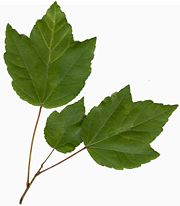 |
|
Sweetgum (Liquidambar styraciflua) Large tree with conical-shaped, spreading crown. Important timber tree among hardwoods for furniture and cabinets. A gum for chewing can be derived from a resin associated with the bark. Sweetgum is an important hardwood used for furniture, cabinets, barrels and plywood. Sweetgum is second only to oaks in this regard. A gum-like resin can be obtained from beneath the bark and used for chewing gum. Leaves: Alternate, 3-6" (7.5-15 cm), star-shaped with 5 (sometimes 7) saw-toothed lobes. Bark: Gray and deeply furrowed. Fruit: Brown ball hanging from stalk with with many fruits ending in prickly points. Habitat: Moist soils of valleys and lower slopes. |
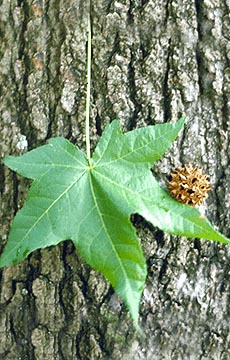 |
 |
|
Tulip or Yellow Poplar (Liriodendron tulipifera) Tall tree with flowers that resemble tulips. Trunks grow straight. and long. Also called Yellow Poplar or Tuliptree. Soft wood of trunk once hollowed out by pioneers for canoes. The soft wood is commercially valuable and used for trim moldings, furniture parts, caskets, wooden utensils, drawer sides, and matches. Leaves: Alternate, 4-8" long with 4 lobes. Bark: Light gray and smooth with furrows developing as ages. Fruit: Winged samaras. Habitat: Moist well-drained soils. |
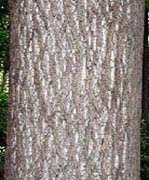  |
 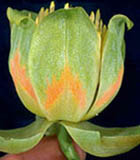 |
|
Water Oak (Quercus nigra) Water oaks grow up to 100 ft tall. They do not tolerate shade and associated with bottomland hardwood forests near streams and ponds. Rapid-growing tree with moderate quality for lumber. Leaves: Alternate, spatula-shaped leaves with smooth to shallowly-lobed margins. Bark: Gray-black with scaly ridges. Fruit: Acorns that occur singly or in pairs. Habitat: Adapted to wet, swampy areas along ponds and streams. |
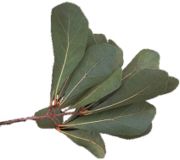 |
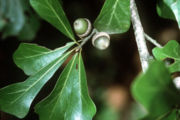 |
|
White Oak (Quercus alba) Grow to 100 feet in height with stout wide-spreading branches and rounded crowns. An important lumber tree with very high-grade hard wood that can be used for a variety of uses. In colonial times, the wood was used for shipbuilding. Acorns are a staple in the diet of a large number of birds (e.g., bluejays) and mammals (e.g., deer, squirrels, chipmunks, raccoons, turkeys, foxes). Leaves: Alternate, 5-9 inches long with 7-9 rounded lobes. Bark: Light gray, scaly, with shallow fissures. Fruit: Acorns with a cup that encloses about 1/4th of the nut. Habitat: Tolerant of a variety of habitats from dry to moist soils. Found at a variety of elevations from lowland valleys to ridges at up to 5,000 ft. |
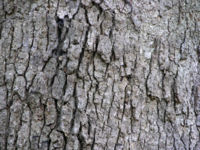  |
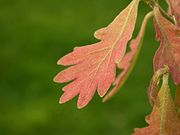 |
